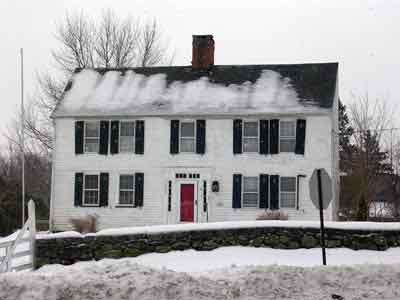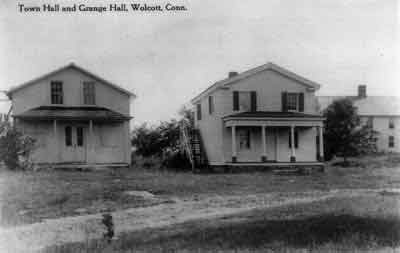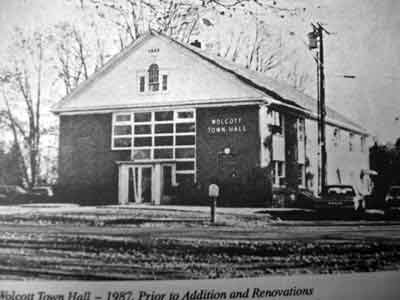|
|
||||||||||||
 |
 |
|
Wolcott Historical Society News - February 2009 By Florence Goodman As I continue this series of articles discussing the history of the existing structures found encompassing our Town Green and historic district, I move onto the Daniel Tuttle House and the Town Hall. The Daniel Tuttle House is located on Kenea Avenue next to the Town Hall. It has been referred to throughout Wolcott history as the "house on the southwest corner of the Green." Daniel Tuttle, a well-known carpenter, erected this 2-1/2-story Federal period post-and-beam home with central chimney in 1792. It was his residence until 1797 when he sold it to Asoph Hotchkiss. Tuttle moved to Plymouth, but this Wolcott house continued to bear his name. The Hotchkiss name is historical because he was one of three men who donated land for the establishment of the Town Green in the early 1800s. In 1852, Erastus Warner, a merchant, moved into the house and lived there for numerous years. In later years, William French owned the house and operated a store and post office on the premises. In 1900, a shed and stone garage were added to the property. In 1918, Mr. French sold the house to Miss Emily Tuttle Morris, daughter of a Connecticut governor. Miss Morris, whose ancestry was from Wolcott, set about restoring this and several other Wolcott houses, which had fallen into ruins. She was responsible for hiring Mr. Frank Arthur Harrison, better known as "Art" to build the beautiful stone wall that surrounds the house and the church. In 1924 Mr. Richard Ely, an official from Chase Brass and Copper Companies, purchased the home and lived there until 1931 when he sold it to Mr. Frederick Moss. Mr. Moss worked for Standard Oil Company of New York. During his ownership, the grounds were landscaped and beautiful flower gardens and shrubs were added. On All Saints Day in 1961, the property was transferred to the Episcopal Society of Connecticut to provide living quarters for the Vicar of the new All Saints Parish. In 1964 the new All Saints Church was erected on the property. There is a historic landmark located south of the church property on Boundline Road called the Great Gray Rock. This was the northeast corner boundary of ancient Waterbury, which dates back to 1678 when the original settlers purchased the land from the Tunxis Indians. Waterbury historians refer to the rock as "The Ordinary." The Boyle family presently owns the Daniel Tuttle house. The Town Hall has seen significant changes throughout its history culminating with a major renovation and addition in 1991 on this historic site. In Colonial times, there was no separation of church and state, therefore town meetings were held at the Congregational Parish until 1839 when that structure was destroyed by fire. After the destruction of the church, town meetings were held outside on the Green until 1856. At that time, the town selectmen purchased an old store located on the south side of the Green from Anson H. Smith for a sum of $350. This building became the first town hall and was referred to as the "Old Town Hall." It was used for government and social activities for seventy years. The Wolcott Drum Band and the Grange used the upstairs of the building for their weekly meetings. The Grange later purchased the building next door and no longer needed the use of the Town Hall. In 1923, the "Old Town Hall" was replaced with a new brick structure. It was a 2-1/2-story Federal Revival-style structure featuring a gable-to-street roof and traprock foundation. The interior and exterior of this building were renovated in 1957. Thirty years later an inspection of the Town Hall by the State of Connecticut revealed that the vaults in several offices were not large enough to safely store and preserve public records and the town was in violation of state statutes. Thus the Town of Wolcott was required to bring the building into full compliance with the law. On September 8, 1989, the groundbreaking for the new building took place and seventeen months later what emerged was a totally new structure. This new building added 9,300 square feet of new space to the 5,700 square feet of old space. We now had a Town Hall that met State requirements as well as expanded working space in every department. The present Town Hall building still houses the original 1923 structure, but the addition and renovations of 1991 were so extensive one might not be able to find that structure. If you look at the front of the building on the right hand side you can still see the original structure with the 1923 date above the circle-top window. Today we have a beautiful state-of-the-art building with a little bit of our history tucked inside. (Much of the information for this article was taken from the "National Register of Historic Places Registration form," completed in 2000, Wolcott Town Hall Dedication Ceremony booklet from articles by Michael R. Brennan and Eileen Coe Jensen, Samuel Orcutt's History of the Town of Wolcott From 1731 to 1874, "Old Salt Box Dwelling On The Green" by Nancy Russo, and "The 1986 Historic Resources Inventory" by J.P. Loether.) Visit our WebPages at (http:/www.wolcotthostory.org/. You can download a membership application there. Please consider helping the Society by becoming a member. Our meetings are held on the first Thursday of each month at the Old Stone School on Nichols Road at 6:30 P.M. During the winter months we do cancel because of bad weather. Anyone interested in visiting the Stone Schoolhouse Museum, please call Loretta Leonard at 879-4310 or Flo Goodman 879-9818.
Daniel Tuttle House
Town Hall and Grange Hall
Town Hall in 1923 To view past installments of the Wolcott Historical Society News, click here. |
|
|
[Home]
[News]
[Purpose]
[Calendar]
[Museum]
[Membership]
[History]
[Contacts]
[Links]
All material at Wolcott Historical Society Web sites Copyright © 2000-2010 Wolcott Historical Society |


